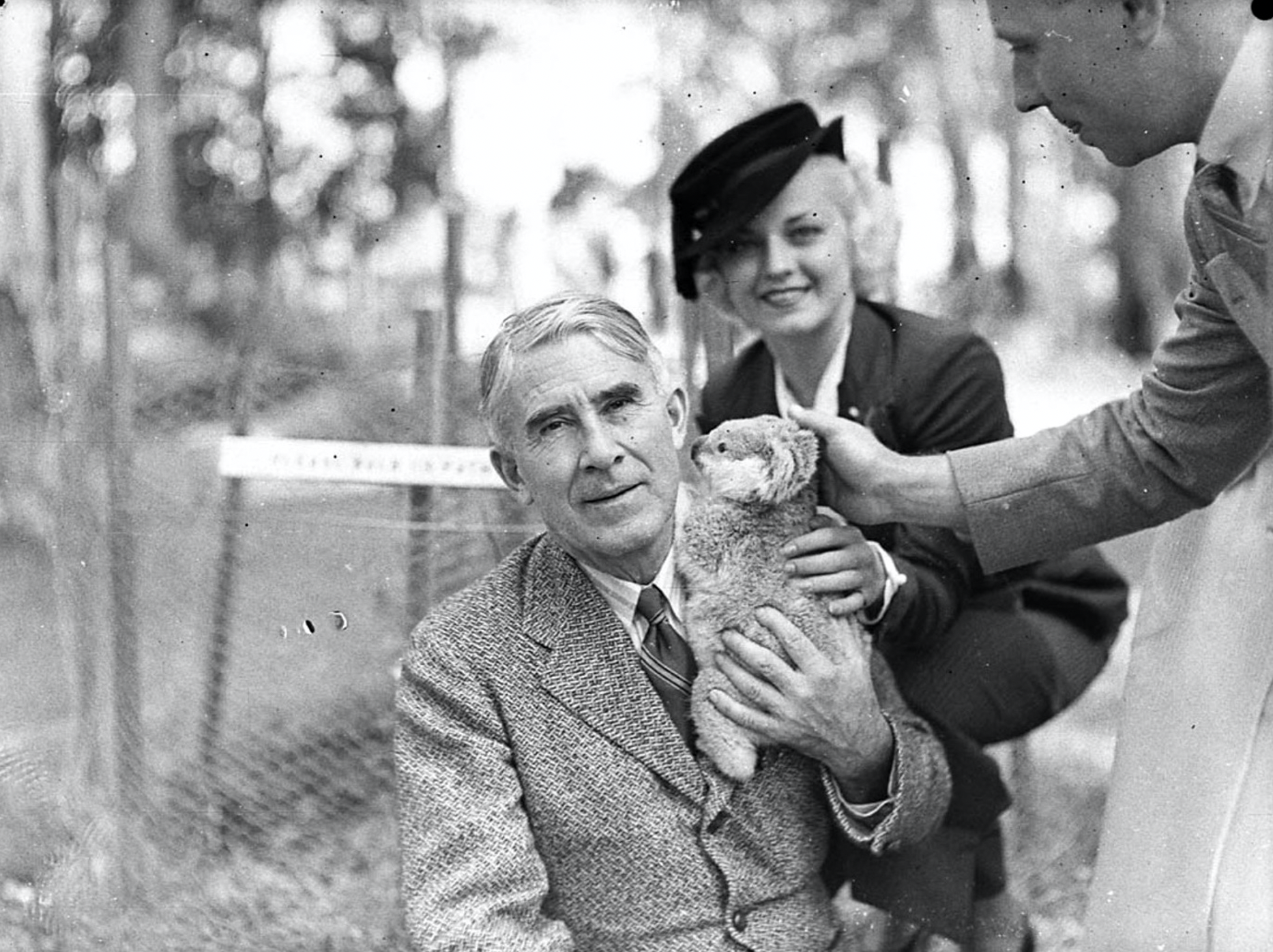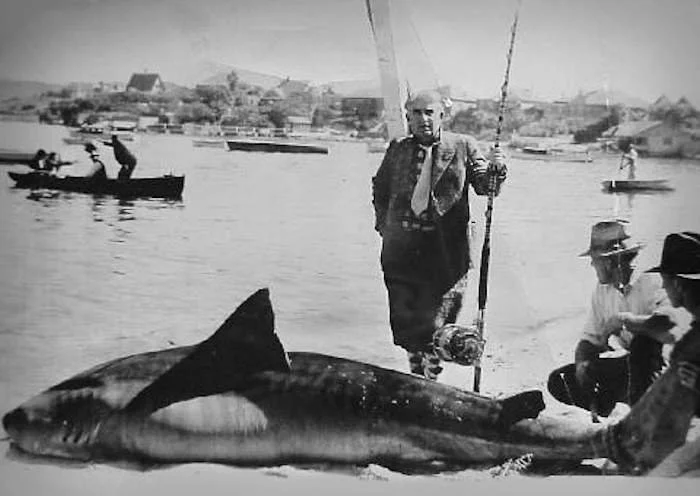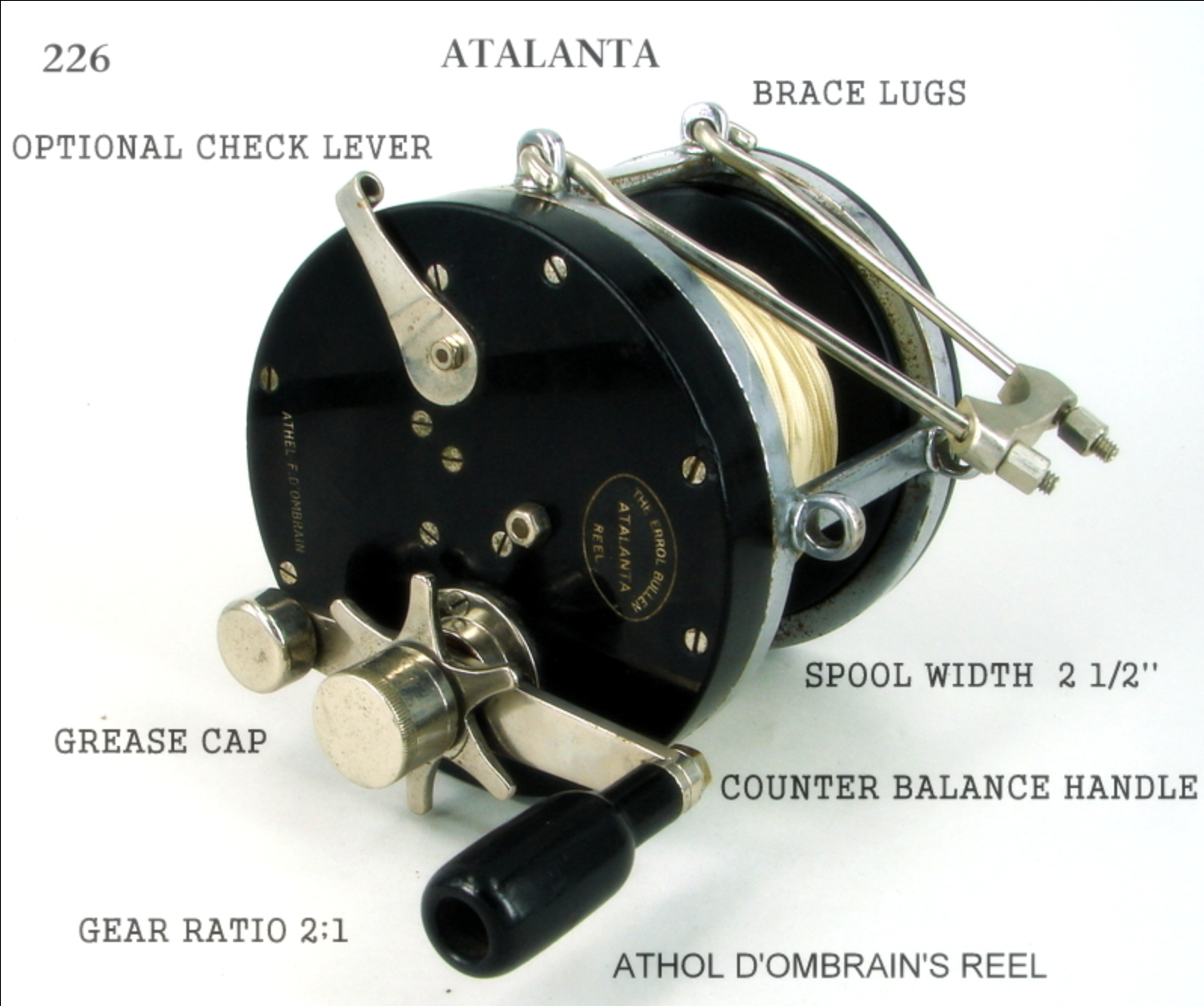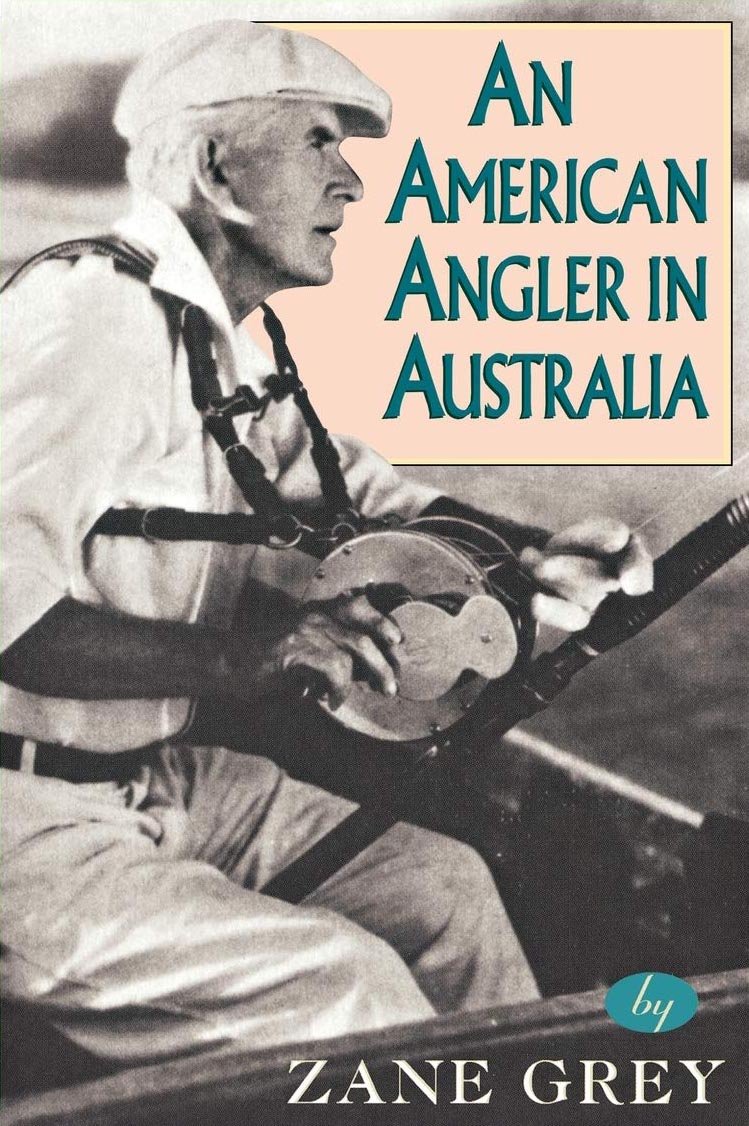ATALANTA, Errol Bullen and Zane Grey
By Malcolm Lambe
The Highly Collectible "Atalanta" Fishing Reels Were Designed By Errol Bullen and named after his gamefishing boat. Bullen Was Instrumental In Coaxing World Famous Angler Zane Grey To Come And Fish Australian Waters For Marlin And Shark.
ZANE GREY was already a man of fame and fortune from writing best-selling westerns when he came to Australia in December 1935 at Errol Bullen’s invitation.
But he was also a pioneering big-game fisherman. Grey was the first man to set up a mothership operation so he could travel the seas in search of broadbill swordfish, giant tuna and marlin.
His first ship FISHERMAN I was a magnificent three-masted schooner of 190 foot long. His second, that he bought in 1930, was a steamship that used to belong to the Kaiser. Grey sunk $300k into renovations on it but it proved to be very roly-poly at sea so for his Australian visit Grey arrived on the luxury liner S.S. Mariposa and at first went out on Australian boats – Errol Bullen’s ATALANTA was used when fishing off Sydney - until his own boat “Avalon” and its skipper were shipped over from New Zealand.
Grey was a tackle innovator, world-record holder and an adventurer in every sense of the word. (Also a womaniser but that’s another story)
He caught the first 1,000-pound marlin ever taken on rod and reel - a big blue caught in Tahitian waters. The fish was ravaged by sharks, but still weighed more than 1,000 pounds.
After doing some sightseeing in Sydney he and his entourage headed down to Bermagui the following month to fish off Montague Island and the Continental Shelf. Ever the self publicist Zane Grey says he got 250-300 curious visitors every day to his camp at Bermagui. It was there that they caught 67 big fish, mostly swordfish, weighing nearly 10 tons.
‘This seems incredible’, he wrote, ‘but it is true.’ And he couldn’t help adding: ‘Two thirds of this number fell to my rod.’
Zane Grey’s mothership Fisherman I. He kept his game boats on deck.
He caught some big fish, but, much to his chagrin, every time pictures of his catches were published, some local identity went out in a grubby boat and, with home-made tackle, caught still bigger fish.
Zane Grey on a fishing boat with a shark he's just caught
Eventually Grey's manager proclaimed that the master angler was not after "small stuff" such as swordfish and tuna. What he had come to Australia for was to catch the "Great White Death" – Grey had seen a Great White he estimated to be at least twenty foot long off Bermagui.
They decided to make a film showing the homeric struggle between man and monster and also to take a dig at various organisations that thought gamefishing barbaric. The star, of course, would be Zane Grey.
A gameboat with the film unit aboard, cruised up and down the Barrier Reef. But no monster great whites were to be found.
For weeks, at a cost of £600 daily, Mr. Grey threw out the most enticing baits he could devise. But a giant “White Death” – that had devoured three people according to the film script – wouldn’t play ball. In desperation one of the film producers decided on a "stand-in" shark. A giant rubber shark was made in Sydney and, in a deflated state, flown to Zane Grey.
On delivery it was blown up, trailed out on the line, and the star of the film did his thing. Long shots and close-ups were taken and then the rubber monster was beached.
When the completed film was given a sneak preview at Bermagui (because it was thought, apparently, that the local fishing population might be sympathetic), the celluloid drama of a rubber shark was greeted with howls of laughter, of which the Marx Brothers would have been proud. But to be fair, it was billed as a “romantic comedy-drama”.
At its Sydney premiere, the theatre was packed with people on invitation. On the second night it was empty. Seems the word was out that it was a bit of a stinker. “Straight to video” you might say.
A world-record tiger shark - a real one not a rubber one - caught by Zane Grey off Sydney Heads in 1936. 13 foot 10 inches long (4.2 M). 1036 pounds (470 kilos) weight. On the beach in front of Doyle's, Watsons Bay.
In his book, “An American Angler in Australia”, Grey wrote, "The reels made for Bullen were just about as good as any reel I own". Upon returning to America Grey asked Bullen to have a large "Atalanta" reel custom-made complete a with level-wind.
Anyway, enough of Zane Grey and gamefishing. Boats is what we’re here to talk about.
Errol Bullen’s game boat ATALANTA was built in 1935 – the year that Zane Grey arrived in Sydney. This website has her listed as built by R. Studdert at The Spit. Perhaps the readers have more information?
She was requisitioned by the Navy in 1940 for War service and towed 27 boats to the safety of Sydney Harbour.
ATALANTA motoring out through Sydney Heads as a liner comes in
After the War, the boat was sent to disposals and was sold to a Chinese man who kept the boat moored at Double Bay. (Click to enlarge)
Around this time – a few years after the war – a bloke called King Hardwick became interested in big game fishing and was using a boat named MARLIN. Hardwick was not satisfied with this boat.
One day while visiting Double Bay in the early 1950’s, he saw a rather disreputable looking boat moored in the bay. With a true-blue water fisherman’s instinct, he knew that here was a frame around which to build a boat. After weeks of negotiations he swapped MARLIN's fittings for the old hulk. After much time and money had been spent on her, in the way of a new V8 engine, two-way radio and other fittings, ATALANTA became one of the finest game fishing launches in Sydney.
Fast forward to Pittwater in the Seventies. I kept an old Kauri timber-hulled Dragon - MAUDE - on a mooring out from Bill Fowler's slips just before Craig Rossie at Palm Beach. Cost me a bottle of Johnnie Walker every month.
There was a guy hanging around the shed - an odd cove - who expressed an interest in buying a boat. Old Bill found him a cruiser that was part of a deceased estate. It was in a neglected state so was sold for $5,000. It was this boat - ATALANTA. I think it was Old Bill that started the rumour of it being Zane Grey’s boat. He was always spinning tall tales. But Zane Grey never owned the vessel ATALANTA – he was only ever a guest on board.
The bloke who bought ATALANTA was renting a waterfront cottage and wharf at Cabarita Road, Careel Bay. He only had the boat a matter of weeks before deciding he was going to restore it. He pulled the Diesel engine out and proceeded to strip the cabin. Everything was removed down to the frames. He found a mast block on the keel and announced "It used to be a yacht!"..."I'm taking her back to sail". How he was going to achieve this I'm not quite sure. He had no job, no income, no boat-building skills and pretty soon couldn't pay the rent and was asked to vacate the premises. The boat sat on the mud and without the superstructure to support her soon twisted.
Shipwright Frank Gonsalves had been watching this lunatic strip the boat and when he saw the state it was in asked the bloke what his intentions were. He was paid $200 to pull the hull off the mud and take it away.
Local legend shipwright and fisherman off the Palm Beach trawler Caroline H, Jimmy Goddard, had also been watching the destruction so he ended up with the boat. He asked me if I knew what happened to the prop and rudder. “Try the scrapyard at Brookvale” I replied. And sure enough he managed to track down not only the shaft and rudder but the lead ballast as well. The bare hull sat at anchor off the mangroves at Careel Bay until eventually Jimmy hauled it out and saved her.
I saw ATALANTA at anchor in Careel Bay and on Gonsalves slips last year and remembered her from forty-something years ago. She always had a sweet-looking hull. Glad she was saved.
ATALANTA on the slip at Palm Beach
Zane Grey with striped marlin and black marlin caught off Bermagui, 14 February 1936














